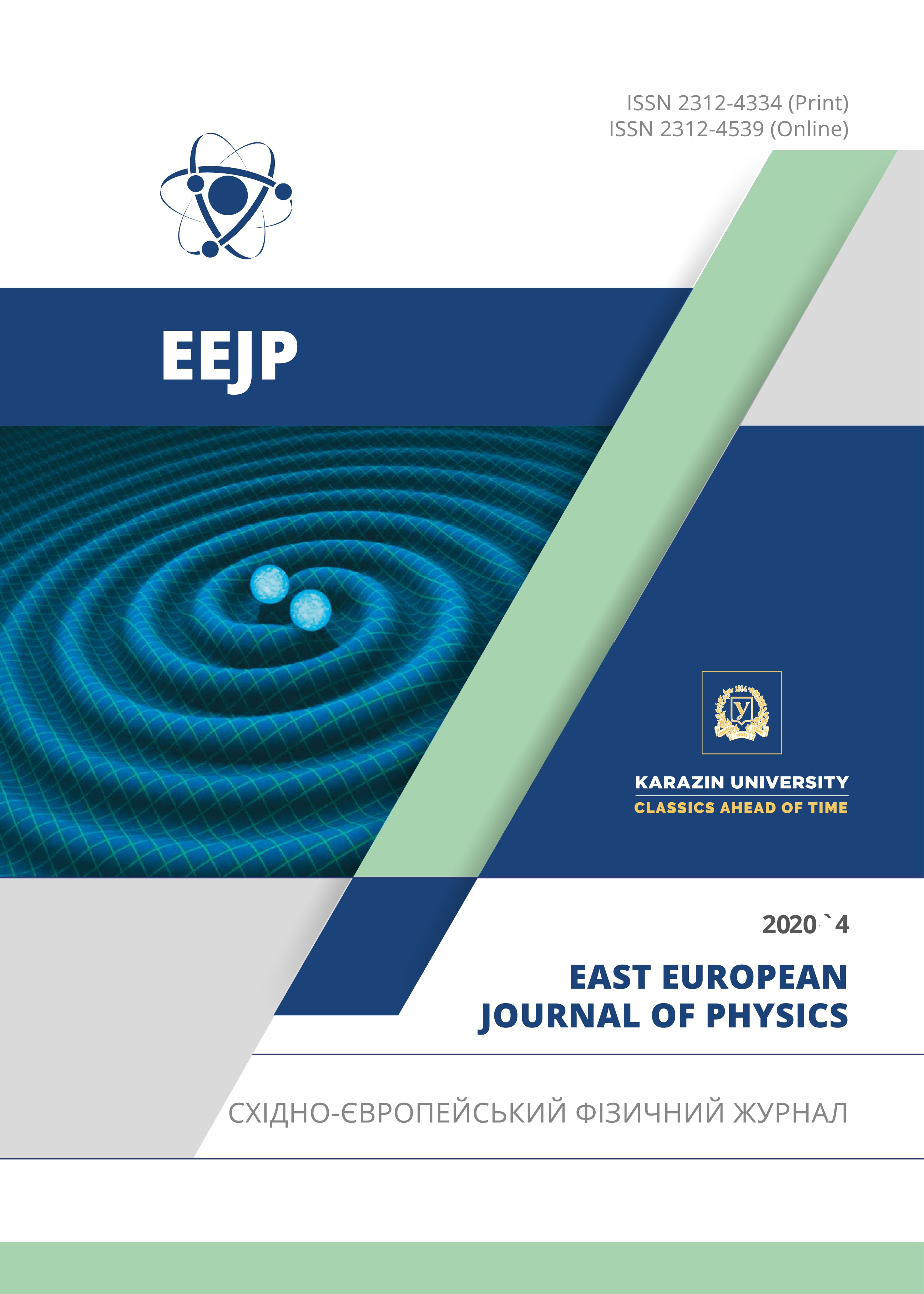Investigation of the Effect of Structuring Methods on the Change in Residul Stresses in Polymer Composite Material
Abstract
The process of forming the cohesive strength of PCM is associated with a decrease in its volume. If there is no mechanical impact on the material, then this process is called shrinkage. Shrinkage occurs during cooling, when the solvent evaporates and during structuring. The free shrinkage of the PCM is hindered by its adhesive bond with the surface of the product, which is filled with a polymer compound, as a result of which more or less shrinkage stresses develop in the PCM over time. In addition to the latter in the PCM there are thermal internal stresses. Their occurrence is due to the combination of different materials in PCM, which differ significantly in the coefficients of thermal expansion. An effective way to reduce internal stresses is to add to the composition of PCM various fillers and plasticizers, what improves the relaxation properties of PCM. The aim of this work was to study the influence of different methods of structuring (polymerization), i.e. by convection and in the field of high frequency currents of epoxy, acrylic and epoxyacrylic PCM. The study of the emerging internal stresses, both shrinkage and temperature, was performed by the method of digital strain gauge, which allows not only to record the final level of residual stresses, but to monitor it in the process of structuring. The studies have shown that a more effective method of structuring is the process of structuring in the field of high-frequency current, which reduces residual stresses, increases the modulus of elasticity and forcing temperature of the studied compounds, what increases the strength and performance properties of PCM, and significantly reduces structuring time, providing uniform heating over the whole volume of PCM. It is recommended to use the obtained data in various industries related to the process of gluing and sealing both homogeneous and heterogeneous materials, as well as PCM products
Downloads
References
Y. Abou Msallem, F. Jacquemin, N. Boyard, A. Poitou, D. Delaunay, and S. Chatel, Composites part a: applied science and manufacturing, 41(1), 108-115 (2010), https://doi.org/10.1016/j.compositesa.2009.09.025.
Y. Zhao, T. Zheng, K. Yang, X. Wang, and Y. He, in: IEEE International Conference on High Voltage Engineering and Application (ICHVE), (IEEE, Athens, 2018), pp. 1–4, https://doi.org/10.1109/ICHVE.2018.8641913.
D. Abliz, J. Zhang, L. Steuernagel, and L. Xie, Journal Polymers and Polymer Composites, 21(6), 341-348 (2013), https://doi.org/10.1177/096739111302100602.
Y. Chen, and G. Malysheva, in: IOP Conference Series: Materials Science and Engineering, 683, 012065 (IOP Publishing, 2019), https://doi.org/10.1088/1757-899X/683/1/012065.
S. Lu, C, Zhao, L, Zhang, D, Chen, D. Chen, X. Wang, and K. Ma, RSC Advances, 39(8), 22078-22085 (2018), https://doi.org/10.1039/C8RA03445A.
L.P. Podgornaya, G.M. Черкашина, and В.В. Lebedev, Теорія та методи дослідження і випробування пластмас, клеїв та герметиків. Навчальний посібник [Theory and methods of research and testing of plastics, adhesives and sealants. Tutorial], (LLC "Pidruchnyk", NTU "KhPI", Kharkiv, 2012), pp. 266.
A.R. Plepys, and R.J. Farnis, Polymer, 31(10), 1932-1936 (1990), https://doi.org/10.1016/0032-3861(90)90019-U.
V. Popovici, D. Gârleanu, G. Gârleanu, and M. Iliescu. In: Proceedings of the 3rd WSEAS international conference on Finite differences - finite elements - finite volumes - boundary elements, edited by M. Grigoriu, V.M. Mladenov, C.A. Bulucea, O.I. Martin, and N.E. Mastorakis, (WSEAS, Wisconsin, US, 2010), pp. 78–81.
M. Harsch, J. Karger‐Kocsis, and F. Herzog, Journals Macromolecular Materials and Engineering, 292(4), 474-483 2007, https://doi.org/10.1002/mame.200600432.
A. Singh, Nucl. Instrum. Meth. B, 185, 50 54 (2001), https://doi.org/10.1016/S0168-583X(01)00753-4.
C. Decker, Macromol. Rapid Comm. 23, 1067–1093 (2003), https://doi.org/10.1002/marc.200290014.
D. Beziers, P. Perilleux, and Y. Grenie, Radiat. Phys. Chem. 48, 171–177 (1996), https://doi.org/10.1016/0969-806X(95)00420-3.
C. Saunders, V. Lopata, J. Barnard, and T. Stepanik, Radiat. Phys. Chem. 57, 441–445 (2000), https://doi.org/10.1016/S0969-806X(99)00411-9.
A.A. Silva, R. Stein, D. Campos, T. Indrusiak, G. Soares, and G.M.O. Barra. Front. Mater. 6, 156 (2019), https://doi.org/10.3389/fmats.2019.00156.
G. Tao, and Z. Xia, International Journal of Fatigue, 29(12), 2180-2190 (2007), https://doi.org/10.1016/j.ijfatigue.2006.12.009.
L. Pupure, S. Saseendran, J. Varna, and M. Basso, Journal of composite materials, 52(24), 3277-3288 (2018). https://doi.org/10.1177/0021998318764275.
S. Paul, M. Motalab, Md.A. Zobayer, and Md.J. Hossain. Strain rate and curing condition effects on the stress–strain behaviour of e epoxy adhesive materials. Journal of Adhesion Science and Technology, 31(16), 1782-1795 (2017), https://doi.org/10.1080/01694243.2017.1283109.
M.B. Prime, Journals Fatigue and Fracture of Engineering Materials and Structures, 22(3), 195-204 (1999), https://doi.org/10.1046/j.1460-2695.1999.00155.x.
B. Winiarski, and P.J. Withers, Journal of Strain Analysis for Engineering Design. 50(7), 412-425 (2015), https://doi.org/10.1177/0309324715590957.
G.S. Schajer, J. Eng. Mater. Technol. 103(2), 157-163 (1981), https://doi.org/10.1115/1.3224988.
M.M. Shokrieh, and A.R.G. Mohammad in: Residual Stresses in Composite Materials, edited by M.M. Shokrieh, (Woodhead Puplishing, 2014), pp. 3 14, https://doi.org/10.1533/9780857098597.1.3.
P. Salagnac, P. Dutournié, and P. Glouannec, AIChE Journal, 50(12), 3149-3159 (2004), https://doi.org/10.1002/aic.10224.
M.M. Reboredo, and A. Vazquez, Curing of thermosetting polymers by an external fluid. Polymer Engineering and Science, 35(19), 1521-1526 (1995), https://doi.org/10.1002/pen.760351905.
S. Liu, Y. Li, Y. Shen, and Y. Lu, The International Journal of Advanced Manufacturing Technology, 103, 3479–3493 (2019), https://doi.org/10.1007/s00170-019-03707-0.
I. Fotiou, A. Baltopoulos, A. Vavouliotis, and V. Kostopoulos, Journal of Applied Polymer science. 129(5) 2754-2764 (2013), https://doi.org/10.1002/app.39003
Copyright (c) 2020 Hanna M. Cherkashina, Vyacheslav L. Avramenko, Oleh H. Karandashov

This work is licensed under a Creative Commons Attribution 4.0 International License.
Authors who publish with this journal agree to the following terms:
- Authors retain copyright and grant the journal right of first publication with the work simultaneously licensed under a Creative Commons Attribution License that allows others to share the work with an acknowledgment of the work's authorship and initial publication in this journal.
- Authors are able to enter into separate, additional contractual arrangements for the non-exclusive distribution of the journal's published version of the work (e.g., post it to an institutional repository or publish it in a book), with an acknowledgment of its initial publication in this journal.
- Authors are permitted and encouraged to post their work online (e.g., in institutional repositories or on their website) prior to and during the submission process, as it can lead to productive exchanges, as well as earlier and greater citation of published work (See The Effect of Open Access).








